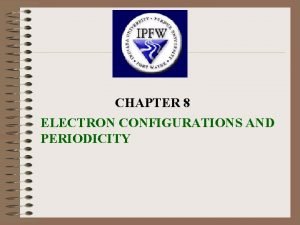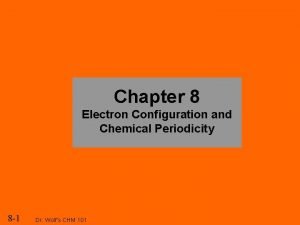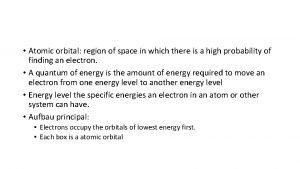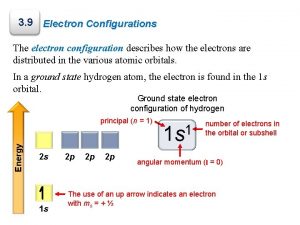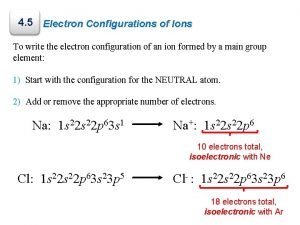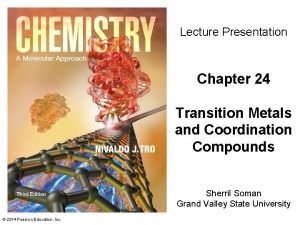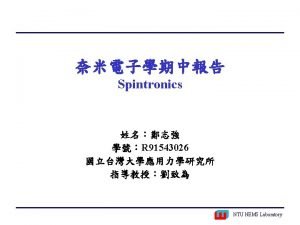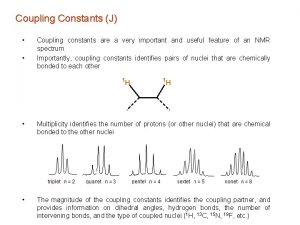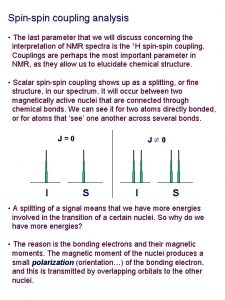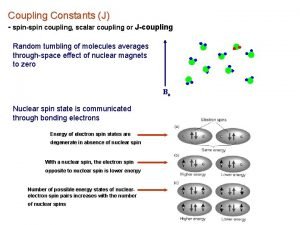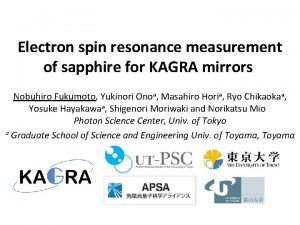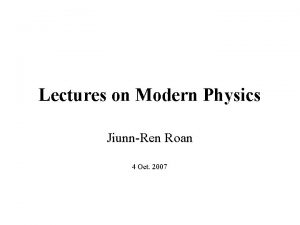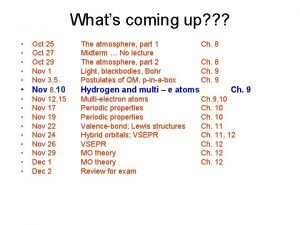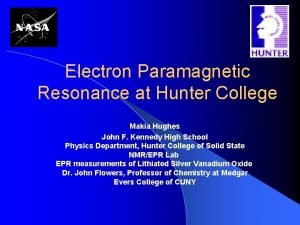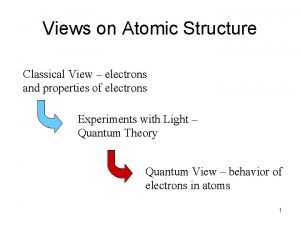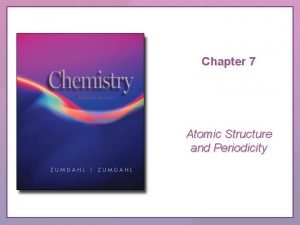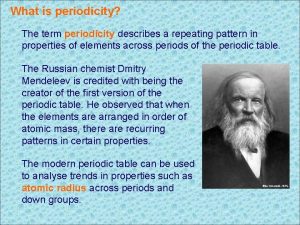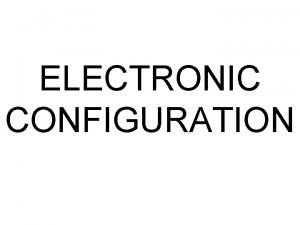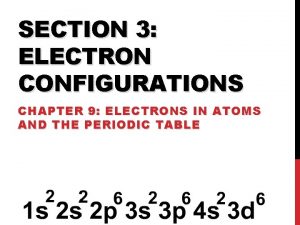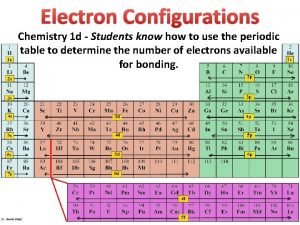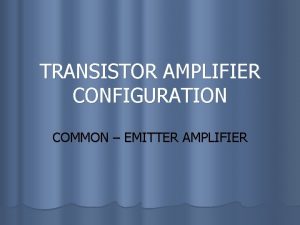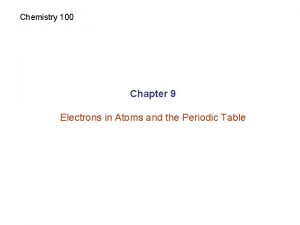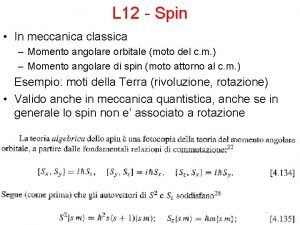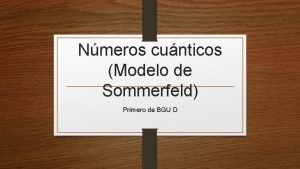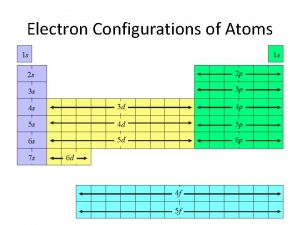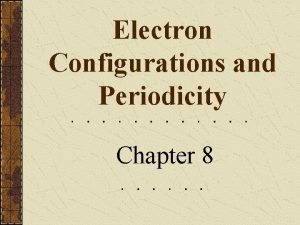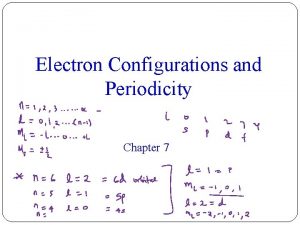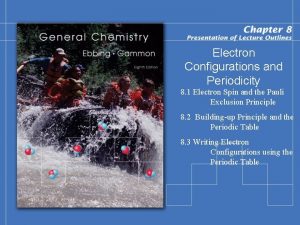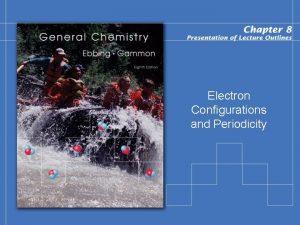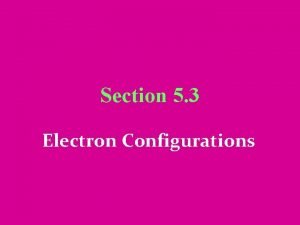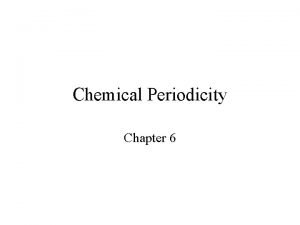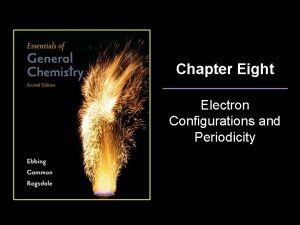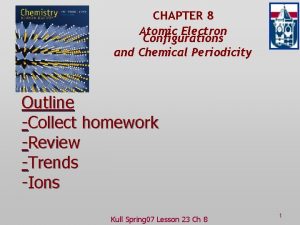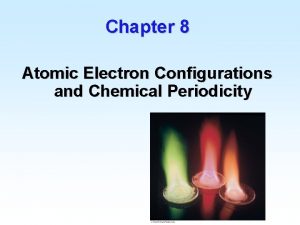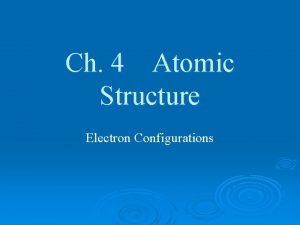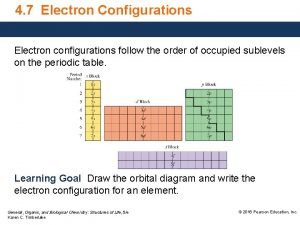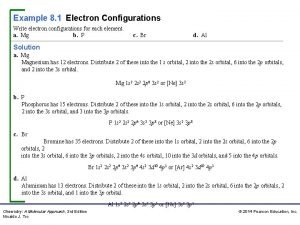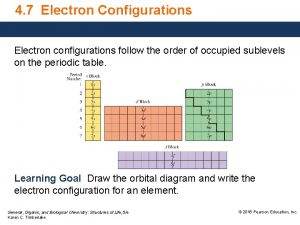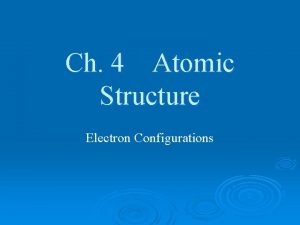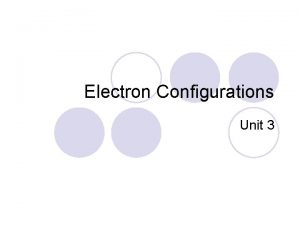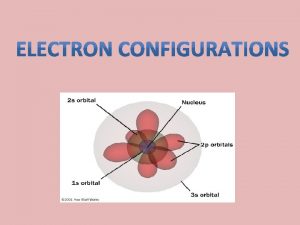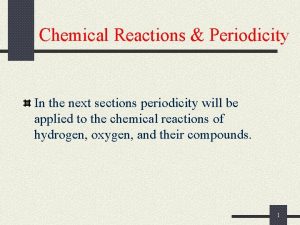Electron Configurations Chemical Periodicity Ch 8 Electron spin








































![Ionization Energy (IE) Mg (g) atom Mg (g) + Mg 3+ [Ne]2 s 735 Ionization Energy (IE) Mg (g) atom Mg (g) + Mg 3+ [Ne]2 s 735](https://slidetodoc.com/presentation_image_h/2c301ba396a2e7a6d5ddbe0542a9b935/image-41.jpg)






- Slides: 47

Electron Configurations Chemical Periodicity (Ch 8) • Electron spin & Pauli exclusion principle • configurations • spectroscopic, orbital box notation • Hund’s rule - electron filling rules • configurations of ATOMS: Na • the basis for chemical valence • configurations and properties of IONS • periodic trends in : • size • ionization energies • electron affinities + Cl Na. Cl Mg + O 2 Mg. O 6 Oct 1997 Chemical Periodicity 1

Arrangement of Electrons in Atoms Electrons in atoms are arranged as SHELLS (n) SUBSHELLS ( ) ORBITALS (m ) Each orbital can be assigned up to 2 electrons! WHY ? . . . Because there is a 4 th quantum number, the electron spin quantum number, ms. 6 Oct 1997 Chemical Periodicity 2

Electron Spin Quantum Number, ms • It can be proved experimentally that the electron has a spin. This is QUANTIZED. • The two allowed spin directions are defined by the magnetic spin quantum number, ms ms = +1/2 and -1/2 ONLY. 6 Oct 1997 Chemical Periodicity 3

Electron Spin Quantum Number MAGNETISM is a macroscopic result of quantized electron spin 5_magnet. mov Diamagnetic: NOT attracted to a magnetic field All electrons are paired N 2 Paramagnetic: attracted to a magnetic field. Substance has unpaired electrons 6 Oct 1997 Chemical Periodicity O 2 4

Pauli Exclusion Principle • electrons with the same spin keep as far apart as possible • electrons of opposite spin may occupy the same “region of space” (= orbital) • Consequences: • No orbital can have more than 2 electrons • No two electrons in the same atom can have the same set of 4 quantum numbers (n, l, ms) OR • “Each electron has a unique address. ” 6 Oct 1997 Chemical Periodicity 5

QUANTUM NUMBERS 6 Oct 1997 n (shell) 1, 2, 3, 4, . . . (subshell) 0, 1, 2, . . . n - 1 m (orbital) - . . . 0. . . + ms (electron spin) +1/2, -1/2 Chemical Periodicity 6

Shells, Subshells, Orbitals #orbitals 0 s 1 1 p 3 2 d 5 3 f 7 0. . (n-1) (2 +1) n 1 2 3 4 n 6 Oct 1997 #e 2 2 6 10 14 2*(2 +1) Chemical Periodicity Total 2 8 PERIOD 1 (H, He) 2 (Li…Ne) 3 (Na. . Ar) 18 32 2 n 2 =0 =1 =2 =3 s p d f etc, for n = 5, 6 7

Element Mnemonic Competition Hey! Here Lies Ben Brown. Could Not Order Fire. Near Nancy Margaret Alice Sits Peggy Sucking Clorets. Are Kids Capable ? 6 Oct 1997 Chemical Periodicity 8

Assigning Electrons to Atoms • Electrons are assigned to orbitals successively in order of the energy. • For H atoms, E = - R(1/n 2). E depends only on n. • For many-electron atoms, orbital energy depends on both n and . • E(ns) < E(np) < E(nd). . . 6 Oct 1997 Chemical Periodicity 9

Assigning Electrons to Subshells • In H atom all subshells of same n have same energy. • In many-electron atom: a) subshells increase in energy as value of (n + ) increases. b) for subshells of same (n + ), subshell with lower n is lower in energy. (n + )= 5 (n + )= 4 5_manyel. E. mov 6 Oct 1997 Chemical Periodicity 10

Effective Nuclear Charge • The difference in SUBSHELL energy e. g. 2 s and 2 p subshells is due to effective nuclear charge, Z*. Charge felt by 2 s e- of Li atom 6 Oct 1997 2 s e- spends more time close to Li 3+ nucleus than the 2 p e. Therefore 2 s is lower in E than 3 s Chemical Periodicity 11

Effective Nuclear Charge, Z* • Z* is the nuclear charge experienced by an electron. • Z* increases across a period owing to incomplete shielding by inner electrons. • For VALENCE electrons we estimate Z* as: Z* = [ Z - (no. of inner electrons) ] • Charge felt by 2 s e- in Li Be B 6 Oct 1997 Z* = 3 - 2 = 1 Z* = 4 - 2 = 2 Z* = 5 - 2 = 3 and so on! Chemical Periodicity 12

Photoelectron Spectroscopy - Measuring IE Photoelectric effect: h + A A+ + eforms basis for DIRECT determination of IE Kinetic energy of electron = h - IE VALENCE therefore: IE = h - KE(e ) ELECTRONS Signal 1 s 6 Oct 1997 Inner shell or CORE ELECTRONS Ar 1 s 309 Ne 2 s 50 100 Chemical Periodicity 2 s 2 p 2 p 3 s 3 p 0 IE (MJ/mol) 13

Electron Filling Order 6 Oct 1997 Chemical Periodicity (Figure 8. 7) 14

Writing Atomic Electron Configurations Two ways of writing configurations. One is called the spectroscopic notation: 6 Oct 1997 Chemical Periodicity 15

Writing Atomic Electron Configurations (2) A second way is called the orbital box notation. One electron has n = 1, = 0, ml = 0, ms = + 1/2 Other electron has n = 1, = 0, ml = 0, ms = - 1/2 6 Oct 1997 Chemical Periodicity 16

Electron Configuration tool - see “toolbox”. 6 Oct 1997 Chemical Periodicity 17

Beryllium Lithium Group 2 A Z=4 1 s 22 s 2 Group 1 A Z=3 1 s 22 s 1 6 Oct 1997 Chemical Periodicity 18

Boron Carbon Z=5 Z=6 1 s 2 2 p 1 1 s 2 2 p 2 Why not ? 6 Oct 1997 Chemical Periodicity 19

Carbon Z=6 1 s 2 2 p 2 The configuration of C is an example of HUND’S RULE: the lowest energy arrangement of electrons in a subshell is that with the MAXIMUM no. of unpaired electrons Electrons in a set of orbitals having the same energy, are placed singly as long as possible. 6 Oct 1997 Chemical Periodicity 20

Nitrogen Z=7 1 s 2 2 p 3 6 Oct 1997 Chemical Periodicity Oxygen Z=8 1 s 2 2 p 4 21

Fluorine Z=9 Neon Z = 10 1 s 2 2 p 5 1 s 2 2 p 6 Note that we have reached the end of the 2 nd period, . . . and the 2 nd shell is full! 6 Oct 1997 Chemical Periodicity 22

GROUPS and PERIODS Sodium Z = 11 1 s 2 2 p 6 3 s 1 or “neon core” + 3 s 1 [Ne] 3 s 1 (uses rare gas notation) Na begins a new period. All Group 1 A elements: Li Na K Rb Cs have [core] ns 1 configurations. (n = period #) 6 Oct 1997 Chemical Periodicity 23

Periodic Chemical Properties REACTIVITY 5_Li. mov 5_Na. mov 5_K. mov 6 Oct 1997 SIZE IE (Ionization Energy) Li Be Na Mg K Ca Rb Sr Cs Ba Alkalis Alkaline Earths Chemical Periodicity 24

Alkaline Earths Metals (ns 2) - easily oxidized to M 2+ - less reactive than alkalis of same period reactivity: Be < Mg < Ca < Sr < Ba WHY? - • Size INCREASES as group • VALENCE e- are farther from nucleus • same Z* - Valence e- less tightly held • Therefore valence e- are easier to remove Typical reactions / compounds Oxides: M +1/2 O 2 (g) MO (s) Ca. O (lime) - #5 Ind. Chem Halides: M + X 2 (g) MX Carbonates: Ca. CO 3 (limestone) Ca. O + CO 2 Sulfates: Ca. SO 4. 2 H 2 O (gypsum) Ca. SO 4. 0. 5 H 2 O (plaster-of-paris) + 3/2 H 2 O RECALL: Solubility rules and PRECIPITATION REACTIONS 6 Oct 1997 Chemical Periodicity 25

Relationship of Electron Configuration and Regions of the Periodic Table s block d block p block f block 6 Oct 1997 Chemical Periodicity 26

Transition Metals Table 8. 4 • Transition metals (e. g. Sc. . Zn in the 4 th period) have the configuration [argon] nsx (n - 1)dy • also called “d-block” elements. 3 d orbitals used for Sc - Zn Chromium 6 Oct 1997 Iron Chemical Periodicity Copper 27

Ion Configurations To form cations from elements : remove 1 e- (or more) from subshell of highest n [or highest (n + )]. P [Ne] 3 s 2 3 p 3 - 3 e- P 3+ [Ne] 3 s 2 3 p 0 6 Oct 1997 Chemical Periodicity 28

Ion Configurations (2) Transition metals ions: remove ns electrons and then (n - 1)d electrons. Fe [Ar] 4 s 2 3 d 6 loses 2 electrons Fe 2+ [Ar] 4 s 0 3 d 6 E 4 s ~ E 3 d - exact energy of orbitals depend on whole configuration 6 Oct 1997 Chemical Periodicity 29

Ion Configurations (3) How do we know the configurations of ions? From the magnetic properties of ions. Ions (or atoms) with UNPAIRED ELECTRONS are: PARAMAGNETIC. Ions (or atoms) without unpaired electrons are: DIAMAGNETIC. 6 Oct 1997 Chemical Periodicity 30

General Periodic Trends • Atomic and ionic radii : SIZE • Ionization energy : E(A+) - E(A) • Electron affinity : E(A-) - E(A) 6 Oct 1997 Chemical Periodicity 31

Atomic Size INCREASES down a Group • Size goes UP on going down a GROUP • Because electrons are added further from the nucleus, there is less attraction. 6 Oct 1997 Chemical Periodicity 32

Atomic Size DECREASES across a period Size goes DOWN on going across a PERIOD. Size decreases due to increase in Z*. Each added electron feels a greater and greater +ve charge. 6 Oct 1997 Chemical Periodicity 33

Atomic Radii 6 Oct 1997 Chemical Periodicity 34

Trends in Atomic Size (Figure 8. 10) 6 Oct 1997 Chemical Periodicity 35

Sizes of Transition Elements(Figure 8. 11) • 3 d subshell is inside the 4 s subshell. • 4 s electrons feel a more or less constant Z*. • Sizes stay about the same and chemistries are similar! 6 Oct 1997 Chemical Periodicity 36

Ion Sizes - CATIONS Does the size go up or down when an atom loses an electron to form a cation? + Li, 152 pm 3 e -, 3 p Forming a cation Li+, 60 pm 2 e -, 3 p • CATIONS are SMALLER than the parent atoms. • The electron/proton attraction goes UP so size DECREASES. 6 Oct 1997 Chemical Periodicity 37

Ion Sizes - ANIONS Does the size go up or down when gaining an electron to form an anion? F, 64 pm 9 e -, 9 p Forming an anion F-, 136 pm 10 e-, 9 p • ANIONS are LARGER than the parent atoms. • electron/proton attraction goes DOWN so size INCREASES. 6 Oct 1997 Chemical Periodicity 38

Trends in Ion Sizes CATIONS ANIONS (59 pm) (207 pm) Trends in relative ion sizes are the same as atom sizes. 6 Oct 1997 Chemical Periodicity 39

Oxidation-Reduction Reactions • Why do metals lose electrons in their reactions? • Why does Mg form Mg 2+ ions and not Mg 3+? • Why do nonmetals take on electrons? - related to IE and EA 6 Oct 1997 Chemical Periodicity 40
![Ionization Energy IE Mg g atom Mg g Mg 3 Ne2 s 735 Ionization Energy (IE) Mg (g) atom Mg (g) + Mg 3+ [Ne]2 s 735](https://slidetodoc.com/presentation_image_h/2c301ba396a2e7a6d5ddbe0542a9b935/image-41.jpg)
Ionization Energy (IE) Mg (g) atom Mg (g) + Mg 3+ [Ne]2 s 735 k. J Mg+ (g) + e- [Ne]2 s 1 Mg+ (g) + 1451 k. J Mg 2+ (g) + e- [Ne]2 s 0 Mg 2+ (g) + 7733 k. J Mg 3+ (g) + e- [He]2 s 22 p 5 Mg 2+ • Energy ‘cost’ is very high to remove an INNER SHELL e- (shell of n < n. VALENCE). • This is why oxidation. no. = Group no. 6 Oct 1997 Chemical Periodicity Mg+ Mg 41

Trends in First Ionization Energy 6 Oct 1997 Chemical Periodicity 42

Trends in Ionization Energy (2) • • IE increases across a period because Z* increases. Metals lose electrons more easily than nonmetals. Metals are good reducing agents. Nonmetals lose electrons with difficulty. • IE decreases down a group • Because size increases, reducing ability generally increases down the periodic table. • E. g. reactions of Li, Na, K 6 Oct 1997 Chemical Periodicity 43

2 nd IE / 1 st IE 2 nd IE: A++ + e- Li Na K 6 Oct 1997 Chemical Periodicity 44

Electron Affinity (EA) • A few elements GAIN electrons to form anions. • Electron affinity is the energy released when an atom gains an electron. A(g) + e- A-(g) E. A. = DE = E(A-) - E(A) • If E(A-) < E(A) then the anion is more stable and there is an exothermic reaction 6 Oct 1997 Chemical Periodicity 45

Trends in Electron Affinity (Table 8. 5, Figure 8. 14) Atom EA (k. J) • Affinity for electron increases B C across a period (EA becomes more negative). N O -27 -122 0 -141 F -328 F Cl Br I -328 -349 -325 -295 • Affinity decreases down a group (EA becomes less negative). 6 Oct 1997 Chemical Periodicity 46

SUMMARY • Electron spin: diamagnetism vs. paramagnetism • Pauli exclusion principle - allowable quantum numbers • configurations • spectroscopic notation • orbital box notation • Hund’s rule - electron filling rules • configurations of ATOMS: the basis for chemical valence • period 2 ; groups • transition metals • configurations and properties of IONS • periodic trends in : • size • ionization energies • electron affinities 6 Oct 1997 Chemical Periodicity 47
 Electron configurations and periodicity
Electron configurations and periodicity Electron configuration and chemical periodicity
Electron configuration and chemical periodicity An orbital is a region of space in an atom where there is
An orbital is a region of space in an atom where there is What are electron configurations
What are electron configurations Ionic 5 electron
Ionic 5 electron Stable electron configurations are likely to contain
Stable electron configurations are likely to contain Stable electron configurations
Stable electron configurations Ccechs
Ccechs Low spin and high spin complex
Low spin and high spin complex 優點
優點 J'
J' Spin spin coupling
Spin spin coupling Spin spin coupling
Spin spin coupling Electron spin resonance takes in
Electron spin resonance takes in Electron spin
Electron spin Larmor precession animation
Larmor precession animation Electron spin
Electron spin Electron spin
Electron spin Electron spin
Electron spin Atom jj thomson
Atom jj thomson Electron spin
Electron spin Electromagnetic periodic table
Electromagnetic periodic table Filariae
Filariae Aap bright futures periodicity schedule
Aap bright futures periodicity schedule Cara memakan ikan
Cara memakan ikan Oxygen periodic trends
Oxygen periodic trends Chapter 7 atomic structure and periodicity
Chapter 7 atomic structure and periodicity Chemsheets periodicity
Chemsheets periodicity Periodic table trend
Periodic table trend What is periodicity
What is periodicity Ap chemistry atomic structure and periodicity
Ap chemistry atomic structure and periodicity Texas health steps check up
Texas health steps check up Electronic configuration rule in chemistry
Electronic configuration rule in chemistry Uses of bjt transistor
Uses of bjt transistor Electrons configurations
Electrons configurations Ceedar innovation configurations
Ceedar innovation configurations Flexible pavement vs rigid pavement
Flexible pavement vs rigid pavement S electrons
S electrons Ac load line analysis of transistor
Ac load line analysis of transistor Electrons configurations
Electrons configurations Empirical formula and molecular formula pogil
Empirical formula and molecular formula pogil Chapter 18 chemical reactions balancing chemical equations
Chapter 18 chemical reactions balancing chemical equations Section 2 classifying chemical reactions
Section 2 classifying chemical reactions Section 1 chemical changes
Section 1 chemical changes Chemical reactions section 2 classifying chemical reactions
Chemical reactions section 2 classifying chemical reactions What is the chemical formula for tetranitrogen heptoxide?
What is the chemical formula for tetranitrogen heptoxide? Spin orbita
Spin orbita Modelo de sommerfeld
Modelo de sommerfeld
